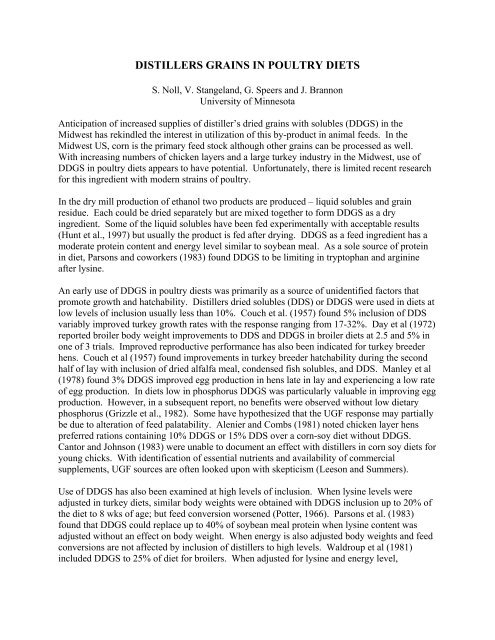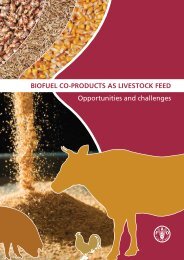Distillers Grains Feeding Recommendations. - Distillers Grains By ...
Distillers Grains Feeding Recommendations. - Distillers Grains By ...
Distillers Grains Feeding Recommendations. - Distillers Grains By ...
Create successful ePaper yourself
Turn your PDF publications into a flip-book with our unique Google optimized e-Paper software.
DISTILLERS GRAINS IN POULTRY DIETSS. Noll, V. Stangeland, G. Speers and J. BrannonUniversity of MinnesotaAnticipation of increased supplies of distiller’s dried grains with solubles (DDGS) in theMidwest has rekindled the interest in utilization of this by-product in animal feeds. In theMidwest US, corn is the primary feed stock although other grains can be processed as well.With increasing numbers of chicken layers and a large turkey industry in the Midwest, use ofDDGS in poultry diets appears to have potential. Unfortunately, there is limited recent researchfor this ingredient with modern strains of poultry.In the dry mill production of ethanol two products are produced – liquid solubles and grainresidue. Each could be dried separately but are mixed together to form DDGS as a dryingredient. Some of the liquid solubles have been fed experimentally with acceptable results(Hunt et al., 1997) but usually the product is fed after drying. DDGS as a feed ingredient has amoderate protein content and energy level similar to soybean meal. As a sole source of proteinin diet, Parsons and coworkers (1983) found DDGS to be limiting in tryptophan and arginineafter lysine.An early use of DDGS in poultry diests was primarily as a source of unidentified factors thatpromote growth and hatchability. <strong>Distillers</strong> dried solubles (DDS) or DDGS were used in diets atlow levels of inclusion usually less than 10%. Couch et al. (1957) found 5% inclusion of DDSvariably improved turkey growth rates with the response ranging from 17-32%. Day et al (1972)reported broiler body weight improvements to DDS and DDGS in broiler diets at 2.5 and 5% inone of 3 trials. Improved reproductive performance has also been indicated for turkey breederhens. Couch et al (1957) found improvements in turkey breeder hatchability during the secondhalf of lay with inclusion of dried alfalfa meal, condensed fish solubles, and DDS. Manley et al(1978) found 3% DDGS improved egg production in hens late in lay and experiencing a low rateof egg production. In diets low in phosphorus DDGS was particularly valuable in improving eggproduction. However, in a subsequent report, no benefits were observed without low dietaryphosphorus (Grizzle et al., 1982). Some have hypothesized that the UGF response may partiallybe due to alteration of feed palatability. Alenier and Combs (1981) noted chicken layer henspreferred rations containing 10% DDGS or 15% DDS over a corn-soy diet without DDGS.Cantor and Johnson (1983) were unable to document an effect with distillers in corn soy diets foryoung chicks. With identification of essential nutrients and availability of commercialsupplements, UGF sources are often looked upon with skepticism (Leeson and Summers).Use of DDGS has also been examined at high levels of inclusion. When lysine levels wereadjusted in turkey diets, similar body weights were obtained with DDGS inclusion up to 20% ofthe diet to 8 wks of age; but feed conversion worsened (Potter, 1966). Parsons et al. (1983)found that DDGS could replace up to 40% of soybean meal protein when lysine content wasadjusted without an effect on body weight. When energy is also adjusted body weights and feedconversions are not affected by inclusion of distillers to high levels. Waldroup et al (1981)included DDGS to 25% of diet for broilers. When adjusted for lysine and energy level,
















